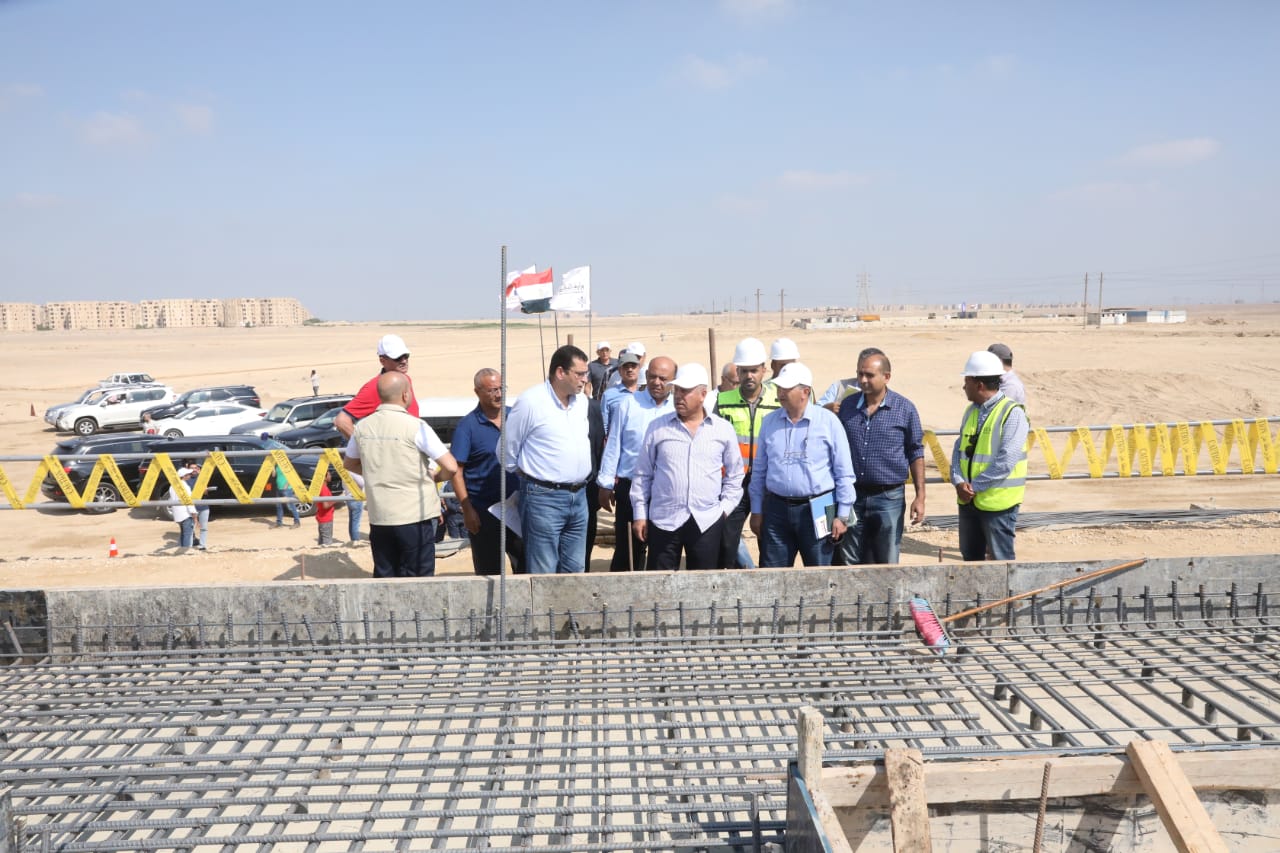The Minister of Transport Inspects the Work Sites of Line 2 of the High-Speed Electric Train Network (October/Aswan/Abu Simbel) 17/09/2023 | 09:59 AM

Lieutenant General Engineer/ Kamel Al-Wazir - Minister of Transport – had continued his inspection tours in various governorates of Arab Republic of Egypt to follow up the projects under implementation, where the Minister of Transport, accompanied by the Chairman and Heads of the General Authority for Roads and Bridges and National Authority for Tunnels, had inspected the work sites of line 2 of the October/Aswan/Abu Simbel high-speed electric train network, with a length of 1,100 km, within the distance from October to Luxor is 673 km.
The Minister had followed up the progress of the implementation rates related to the various sectors of the project, as the connection point with line 1 of (Ain Sokhna/Matrouh) high-speed electric train was inspected at October Gardens zone, which will be an interchange station between the two lines, as the passage of line 1 trains in this station will be a ground passage, while line 2 will be an overhead passage. The Minister of Transport had inspected the remaining sectors of the relevant route and its intersection with various roads such as (the middle (the 2nd) ring road, the regional ring road, the Western Upper Egypt, Beni Mazar/Al-Bouiti, Dayrout/Al-Farafra, and other roads within this route), in addition to the follow up of the implementation works of the railway bridge and industrial works located within the said route.
The Minister of Transport had also inspected the work sites of 25 stations within the said route, out of a total of 36 stations that constitute the number of stations of line 2 of the high-speed electric train network, including 6 stations for the high-speed electric trains, namely (Al-Fayoum / Beni Suef – Al-Minya - Assiut - Sohag - Qena - Luxor), and 19 stations for the trains of the regional area, namely (Al-Ayat - Al-Fashn - Al-Adwa - Beni Mazar – Samalout), which the Minister had instructed, upon inspection, to carry out the necessary study of the traffic movement and the relevant approaching methods, and (Abu Qurqas - Mallawi - Dayrut - Al-Qusiya - Manfalut - Abutig - Al-Ghanaim - Tahta - Jahayna - Abydos - Farshout - Nag Hammadi - Dashna - Qus) where the Minister had followed up the implementation works of the concrete structure of the stations and the timetable of the relevant implementation period of time.
The Minister of Transport had instructed that all works shall be carried out in accordance with high quality standards, and that Al-Fayoum/Beni Suef station shall be a special station regarding the entrances of this station, and that the said entrances shall be from both sides to serve Beni Suef and Al-Fayoum governorates, where the Minister of Transport had confirmed that the location of the stations being generally close to roads, residential places and intersection areas with The Nile axes had been taken into consideration to serve the residents of Upper Egypt governorates, and also that all approaching methods to the said stations shall be free and serve all directions of traffic, in order to facilitate travelers to reach the stations from all directions and from all nearby cities and villages.
The Minister of Transport had confirmed that the route should be as close to or within the western side of the way as possible, in order to reduce the area of expropriation works for buildings and lands, especially from the existing agricultural lands, and to intensify work around the clock, taking into consideration the importance of the project which will represent a huge qualitative leap in the means of green, sustainable and eco-friendly public transportation in Egypt.
During his tour, the Minister of Transport confirmed in press statements that this line is a part of the logistical development corridor (Alexandria/Cairo/Aswan/Toshka), one of which goals is to create a development corridor in the western route of the Western Upper Egypt Desert Road and link between the agricultural production areas in Toshka, west of Aswan, west of Al-Minya with the consumption areas in Cairo and the export areas in Alexandria, in addition to linking between the touristic areas starting from Abu Simbel, Aswan, Luxor, Abydos, and Upper Egypt with the Al-Ahram and Giza area in Cairo, pointing out that line 2 contributes to link between the raw materials production areas and quarries (Abu Tartur - Qena - Aswan) with the export ports, and contributes also to reduce the environmental pollution resulting from the operation of diesel tractors.
It is worth mentioning that the High-Speed Electric train network, currently under construction, consists of 3 main lines with a total length of about 2,000 km, including about 1,400 km to serve Upper Egypt, in parallel with the ongoing development of the currently existing railway network with a length of 10,000 km. The length of line 2 of the network(October / Aswan / Abu Simbel) is 1100 km, and includes (36) stations, one centralized control center, and one workshop for major heavy and general overhaul works, in addition to 3 maintenance and storage points located in the areas (Aswan - Abu Simbel - Safaga). The design speed of the network is 250 km/h and the operational speed of the High-Speed electric trains is 230 km/h, the operational speed of the regional electric trains is 160 km/h, and the operational speed of the trains transferring goods is 120 km/h. The number of the High-Speed electric trains on this line is scheduled to reach 20 trains, and the regional electric trains will reach 48 trains at a speed of 160 km/h, and 20 tractors, transferring goods, to ensure achieving the greatest financial return that covers operation and maintenance expenses later, where the Minister of Transport had advised that the goal of diversifying the rolling stock (fast and regional) is to provide a civilized means of transportation that suits all income levels, while providing a distinguished service.